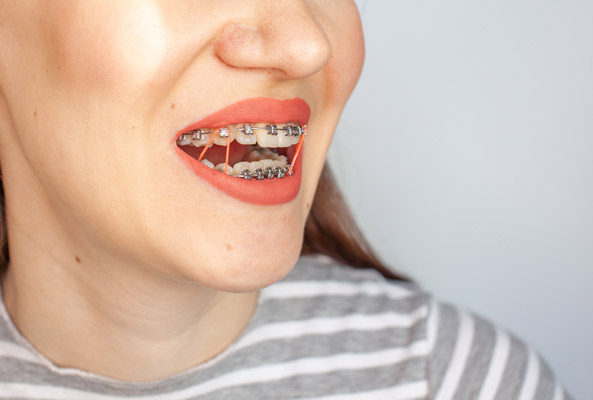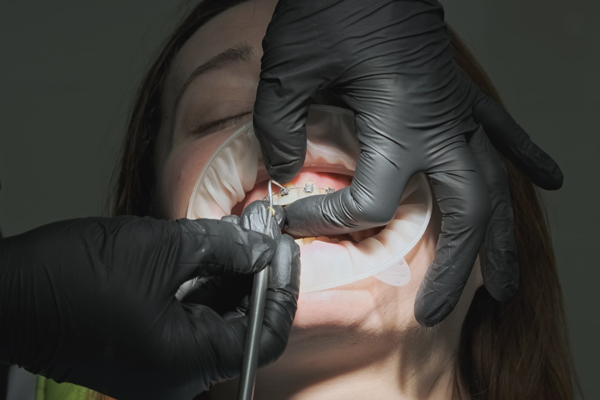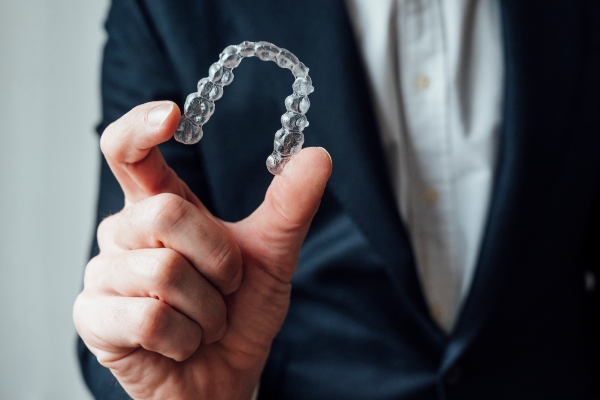How an Orthodontist Uses Elastics for Treatment

Often, the primary focus of treatment from an orthodontist is addressing misaligned teeth. However, jaw misalignments can also cause cosmetic and oral health concerns. To help ensure the adequate correction of jaw alignment, as well as the teeth, orthodontists may use elastics.
How an orthodontist uses elastics during orthodontic treatment
Orthodontists use elastics to treat bite complications such as crossbites, overbites, and underbites. Elastics are used at the same time as braces (or sometimes clear aligners) to allow for quicker results for patients. This review discusses the role of elastics in treating jaw and teeth misalignment through orthodontic care.
What are elastics in orthodontic treatment?
Elastics in orthodontic treatment, also sometimes called inter-arch rubber bands, are stretchable loops that are strategically positioned to keep the upper and lower jaw in the proper position. They are used to correct various bite complications that are common among orthodontic patients. The elastics are generally made of latex material. Elastics are most commonly used with traditional braces, although some clear aligner treatments utilize a variation of elastics to achieve a similar purpose.
When would an orthodontist use elastics?
Orthodontists use elastics to correct bite misalignments for their patients. Treatments such as traditional braces pull teeth into better alignment. However, this is not always enough to correct the jaw misalignment, in which case, elastics are used. Examples of bite complications that an orthodontist may address with elastics include:
- Overbite
- Underbite
- Crossbite
- Open bite
An orthodontist can assess the severity of the misalignment during the consultation or early on in the treatment process and determine what role elastics should play, if any, in the treatment plan.
The importance of wearing elastics if recommended
Not all orthodontic patients are required to wear elastics, although many (if not most) patients will have to at some point during their treatment. Elastics can feel slightly uncomfortable and awkward at first. It is important to not stop wearing the elastics after the initial discomfort, as the jaw misalignment may not improve from the braces or clear aligners treatment alone.
The long-term benefits of wearing elastics
The purpose of elastics is to correct jaw misalignments. In doing so, the patient can improve the appearance of their smile with a more symmetric and even bite. While many are familiar with the cosmetic benefits, fewer are aware of how elastics can improve oral health. People with bite complications are at an increased risk of bruxism, which could damage teeth and increase the risk of temporomandibular joint disorder. Elastics correct the bite, reducing these risks, in addition to creating a more attractive jaw alignment.
Common questions about orthodontic elastics
Here are the answers to some common questions about elastics during orthodontic treatment to help you determine if they are right for you and ensure they are worn properly if they are recommended.
How long does it take for elastics to correct a bite?
This depends on how well the patient follows the orthodontic plan. In most cases, patients are asked to wear their elastics for 24 hours a day, only removing them when it is absolutely necessary. When worn properly, the patient should see and feel noticeable results in approximately seven months, although results may vary widely depending on the severity of the malocclusion and the patient’s age.
What are the dos and don'ts of wearing elastics?
Of course, the most notable instruction for elastics is to wear them as much as possible. Otherwise, the jaw has a tendency to remain in its current alignment. Patients are usually advised to remove them while brushing and eating, but the elastics should be replaced right afterward. It is not recommended to ever double up on your elastics even if you miss a day of wearing them; this is actually counterproductive and may slow the success of treatment.
Do I have to wear elastics while I eat?
Elastics are most effective when they are worn 24/7. This means it is recommended that you wear them while you are eating. However, in cases where eating becomes too challenging because of the elastics, they may be removed. It is important to replace them once you are finished eating.
The bottom line
Here at our orthodontic practice, we do all that we can to ensure that all our patients have a positive experience. If you are not happy with the alignment of your teeth and jaw or are searching for an experienced orthodontist for your child, contact our practice today to schedule a consultation.
Request an appointment here: https://www.brooklyn-orthodontist.com or call Brooklyn Heights Orthodontics: Susan Liebman, DMD at (718) 416-6368 for an appointment in our Brooklyn office.
Check out what others are saying about our dental services on Yelp: Orthodontist in Brooklyn, NY.
Recent Posts
While orthodontic treatment is often associated with straightening teeth and correcting bite issues, it can come with unique challenges. A braces specialist offers professional care that goes beyond addressing basic orthodontic needs. Through their care, patients of all ages can receive the personalized treatment they need to achieve a healthy smile.A braces specialist is a…
There are several myths and misconceptions about orthodontics. This is the process of correcting teeth alignment issues using appliances like clear alignments and metal braces. Treatment with orthodontics sometimes also leads to improvements in a person’s facial structure and appearance.Misaligned teeth can ruin how a smile looks and can also increase the risk of issues…
Orthodontics can improve your appearance, but it can also improve the alignment of your teeth and jaw, which in turn, can improve your oral and systemic health. Orthodontic problems affect the health of a patient in different ways. Eliminating the root cause (usually a bad bite) can eliminate other problems that stem from the orthodontic…
There are different types of appliances to choose from when it comes to orthodontics. These appliances typically work by pushing on the wearer’s teeth, gradually improving their alignment over time. Malocclusions, or bite problems, that can be treated with oral appliances include: Crooked teeth Spaces between teeth Overbites Underbites Crossbites Addressing poor teeth alignment provides…


